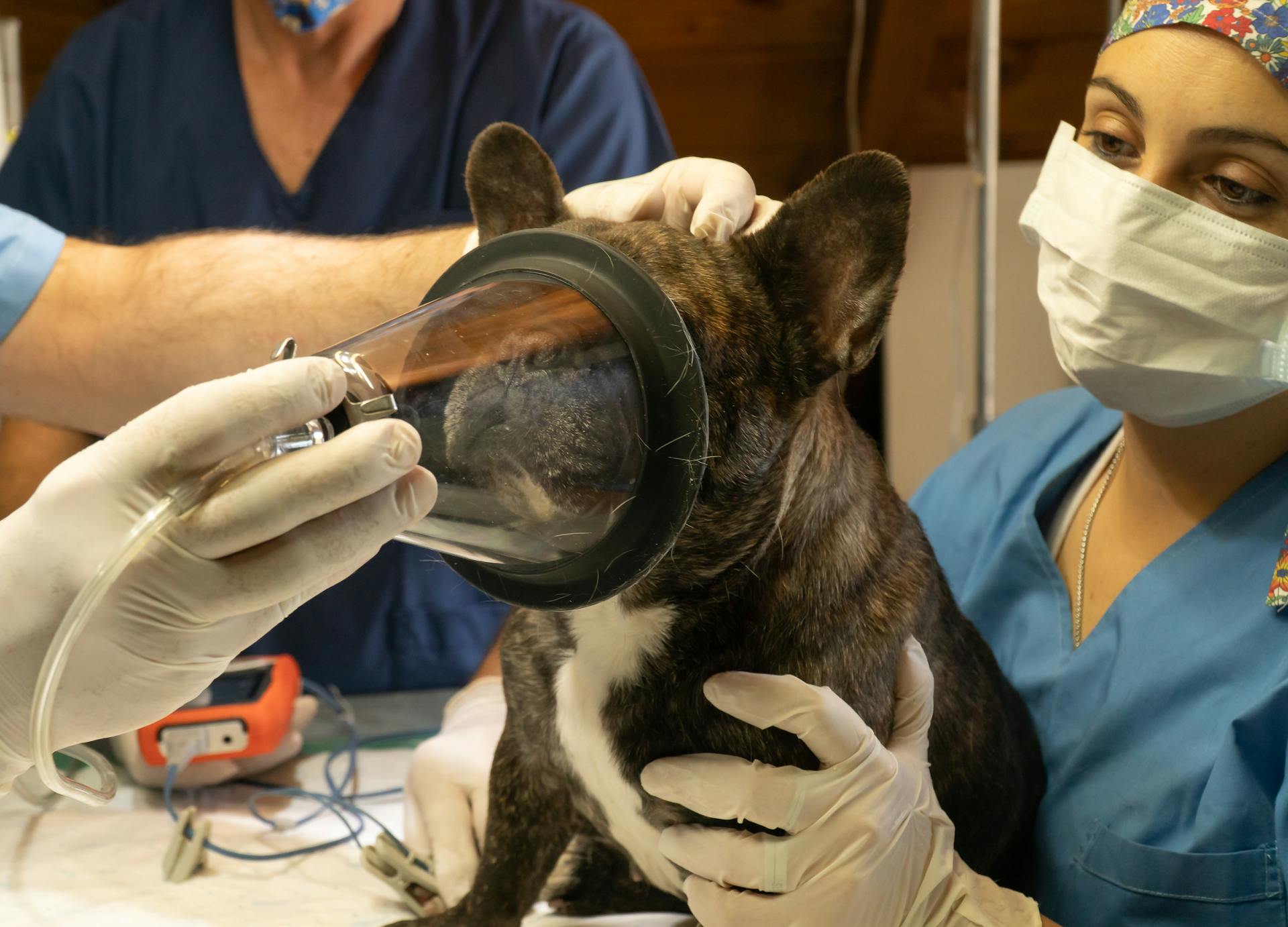
Spaying a female dog can have a significant impact on her behavior and overall health. According to research, spayed dogs exhibit reduced roaming behavior, resulting in fewer unwanted pregnancies and reduced risk of contracting diseases.
Spaying can also reduce aggression in female dogs. Studies have shown that intact females are more likely to exhibit dominant behavior, such as growling and snapping, whereas spayed females tend to be more relaxed and less aggressive.
One of the most significant benefits of spaying is the reduction of certain health issues. For example, spayed dogs are less likely to develop uterine infections and breast tumors.
Spaying can also lead to a reduction in undesirable behaviors, such as whining and pacing, which are often associated with heat cycles.
Behavior Changes
Spaying a female dog can lead to a reduction in aggression, irritability, and overt sexual behavior, making them appear calmer and more relaxed. This is because spaying eliminates the hormonal fluctuations that can drive these behaviors.
Spaying can also reduce urine-marking behavior and decreases roaming behavior in intact males pursuing females in season. However, it's essential to note that not all aggression in dogs is hormone-related, and spaying won't magically fix all aggression issues.
Spaying can help rebalance hormonal issues, such as phantom pregnancies, which can be distressing for dogs. These pregnancies can cause anxiety, aggression, and even depression in some cases.
Some dogs may exhibit a "hysterical pregnancy" after going into heat, where they act protective of objects they consider as their "puppies." This behavior can be a sign of hormonal imbalance.
Spaying can reduce estrogen levels, leading to a decrease in hormonal fluctuations and potentially making a female dog appear calmer. However, the results can vary between dogs, and spaying is not a guaranteed solution to all aggression issues.
Here are some potential benefits of spaying a female dog:
- Reduced aggression and irritability
- Decreased overt sexual behavior
- Reduced urine-marking behavior
- Decreased roaming behavior in intact males
- Rebalanced hormonal issues, such as phantom pregnancies
Keep in mind that every dog is unique, and the results of spaying can vary. It's essential to consult with a veterinarian to determine the best course of action for your dog's specific needs.
You might enjoy: Dog Names Female Start with S
Spaying Process and Risks
The spaying process typically takes around 30 minutes to an hour, but can vary depending on the individual dog and the veterinarian's experience.
During the procedure, the veterinarian will make a small incision in the dog's abdomen to access the reproductive organs. The ovaries and uterus are then removed, and the incision is closed with sutures or staples.
Some spayed dogs may experience a slight decrease in body temperature, as the reproductive organs help regulate body heat. This is usually temporary and resolves on its own.
The most common risks associated with spaying include infection, bleeding, and adverse reactions to anesthesia. These risks can be minimized by working with an experienced veterinarian and following post-operative care instructions carefully.
Spayed dogs may also be more prone to certain health issues, such as urinary incontinence and obesity, due to changes in hormone levels. Regular check-ups and a healthy lifestyle can help mitigate these risks.
For another approach, see: Risks of Not Spaying Female Dog
Health and Hormones
Spaying a female dog can significantly reduce hormone production and end the reproductive cycle. This process usually takes a few weeks to a few months, although the timeline can vary from one dog to another.
Hormones play a significant role in a female dog's behavior, and hormonal changes can make them irritable, annoyed, and more aggressive. Spaying a female dog leads to a drop in estrogen levels, reducing hormonal fluctuations.
Spaying can help rebalance the hormonal issues your dog is experiencing, which can lead to a more relaxed and calmer demeanor. Many dog owners have reported a significant reduction in aggression or hyperactivity after spaying their female dogs.
On a similar theme: Hormonal Female Dog Behaviour
Weight Gain Risk
Some dogs may experience weight gain after spaying, and this can be controlled by changing their diet and activity schedule.
This weight gain is a possibility due to a shift in their metabolism.
Not every dog will respond to spaying in the same way, and not all behavioral changes will occur.
The degree of behavioral alterations can vary depending on when spaying occurs, and the largest behavioral benefits can be obtained by spaying before the first heat cycle.
It's essential to consider how spaying might affect your dog's general health.
For another approach, see: Sudden Weight Gain in Female Dog
Hormone Duration in Dogs
Hormones in dogs play a significant role in their behavior, and understanding how long they last after spaying is crucial.
It usually takes a few weeks to a few months for hormone levels, especially estrogen and progesterone, to completely leave a dog's system after spaying.
Some dogs may experience a faster decline in hormone levels, while others might continue to have some hormonal effects for a bit longer.
The timeline can vary from one dog to another, but spaying significantly reduces hormone production and ends the reproductive cycle.
Any remaining effects are typically minor and don't have a significant impact on the dog's overall well-being or behavior.
Here's a rough estimate of the hormone duration in dogs after spaying:
Keep in mind that the exact timeline can vary depending on the dog, her cycle, and the reason for her hyperactivity.
If you have concerns about your dog's behavior or hormones, it's always best to consult with a veterinarian for personalized advice.
Individual Health Considerations
Spaying a dog may need to be done at a different age depending on its health issues. The vet can advise on the best time to spay the dog based on its unique medical requirements.
The ideal time to spay a dog depends on its breed, size, health, and unique traits. Your vet can take all these factors into account when making a recommendation.
In some cases, the decision to spay a dog may be influenced by its breed and size. Larger breeds may need to be spayed earlier to prevent certain health issues.
The decision-making process should also include talks about the possible advantages and disadvantages of spaying at various ages. This will help you make an informed decision that's right for your dog.
Myths and General Information
Spaying a female dog doesn't make her fat, it actually helps prevent certain types of tumors and cancers.
Some people think that spaying a female dog will make her lazy, but studies have shown that spayed dogs are just as active as intact dogs.
Spaying a female dog before her first heat cycle can reduce the risk of breast tumors and uterine infections.
Spayed dogs can still get breast cancer, but the risk is significantly lower than in intact dogs.
Spaying a female dog won't affect her temperament, but it may reduce her desire to roam in search of a mate.
Spayed dogs can still be trained and socialized just as well as intact dogs.
Spaying a female dog can help reduce unwanted breeding and pet overpopulation.
For more insights, see: Intact Female Dog
Helping Your Dog Relax After Surgery
Spaying can make a female dog appear calmer, but it's not a guaranteed solution to all aggression issues.
The decrease in estrogen levels after spaying can affect her reproductive cycle and reduce hormonal fluctuations.
It's essential to understand that spaying may not lead to significant changes in some dogs, as each dog is unique.
The time it takes for your dog to calm down after spaying depends on her reproductive cycle when the procedure was performed.
For your interest: Female Dog Reproductive
It may take about 2-3 months to see a significant decrease in hyperactivity, but the exact timeline can vary depending on the dog, her cycle, and the reason for her hyperactivity.
Spaying can reduce hormonally-driven behavior, such as aggression, irritability, or overt sexual behavior.
This can mean your female dog will be more relaxed, calmer, and could be a lot happier.
If your dog experiences phantom pregnancies, spaying can help rebalance the hormonal issues she's experiencing.
Phantom pregnancies can be distressing, causing anxiety, depression, and aggressive behavior in some dogs.
Spaying can help reduce these symptoms and improve your dog's overall behavior and wellbeing.
After spaying, it's essential to provide a calm and comfortable environment for your dog to adjust to her new hormonal balance.
A quiet and peaceful space can help reduce stress and anxiety, allowing your dog to settle down and relax.
Explore further: Female Dog Phantom Pregnancy
Timing and Considerations
The ideal time to spay your dog depends on your consultation with your veterinarian, who will take into account your dog's breed, size, health, and unique traits.
Your veterinarian may advise spaying your dog at a different age based on particular health issues, such as those that affect your dog's overall medical requirements.
The decision-making process should include discussions about the possible advantages and disadvantages of spaying at various ages, allowing you to make an informed decision.
Frequently Asked Questions
How long does it take for a dog to act normal after being spayed?
Your dog will likely take 10-14 days to recover and return to normal behavior after being spayed, during which time it's essential to keep them quiet and calm
How long does it take for a female dog to feel better after being spayed?
Most female dogs start to feel better within 24-48 hours after spaying surgery, but full recovery typically takes around 10-14 days
Sources
- https://feastfido.com/dog-behavior-change-after-spaying/
- https://www.whole-dog-journal.com/behavior/does-spaying-or-neutering-change-dog-behavior/
- https://www.petplan.co.uk/pet-information/dog/advice/does-neutering-change-dog-behaviour/
- https://www.psychologytoday.com/us/blog/canine-corner/201702/are-there-behavior-changes-when-dogs-are-spayed-or-neutered
- https://parliamentanimalhospital.ca/will-spaying-calm-female-dog/
Featured Images: pexels.com


